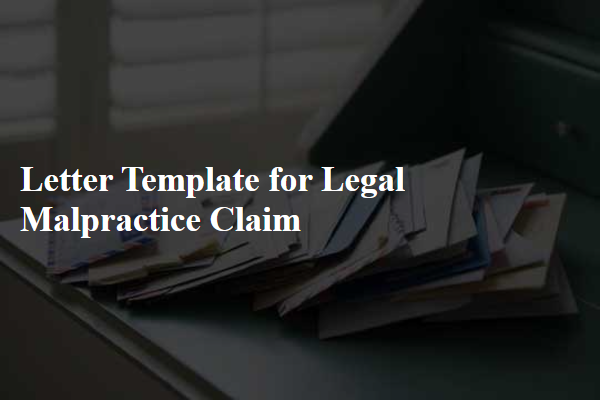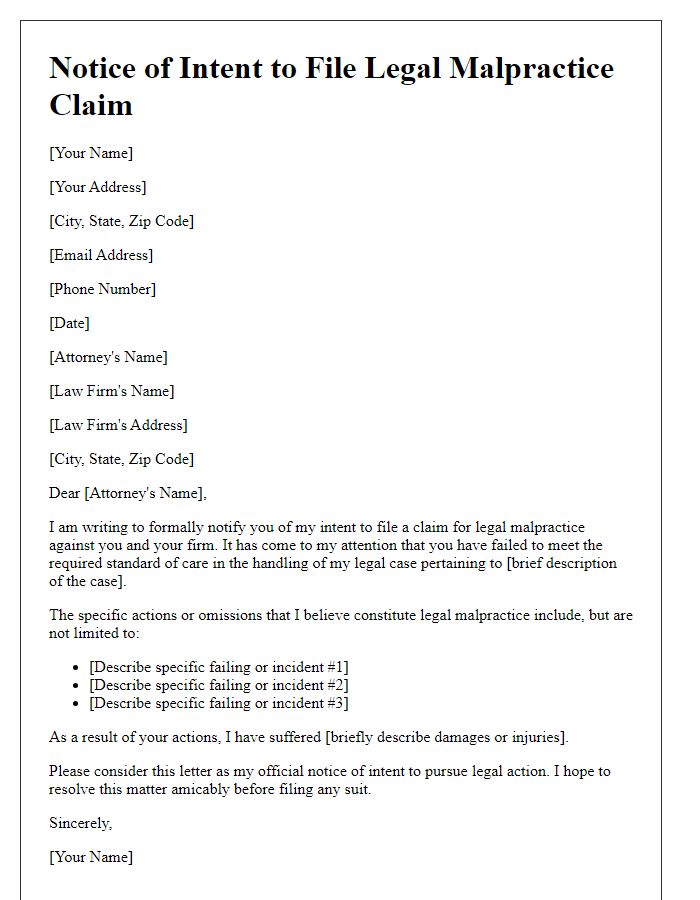Are you feeling overwhelmed by the complexities of a legal malpractice claim? You're not alone; many individuals find themselves in similar situations, navigating the challenging waters of the legal system after experiencing inadequate representation. Knowing how to articulate your concerns and seek justice is crucial, and having a solid letter template can make all the difference. If you're ready to empower yourself and learn the steps involved, we invite you to read more on this essential topic.

Clear Identification of Parties Involved
The legal malpractice claim identifies key parties including the aggrieved client, often referred to as the Plaintiff, and the attorney or law firm accused of negligence, designated as the Defendant. The Plaintiff generally seeks redress for damages sustained due to alleged failures in legal duty by the Defendant, who may represent a specific law practice located in a notable city such as New York, Los Angeles, or Chicago. Essential details include the parties' names, addresses, and professional qualifications, such as the attorney's license number and the firm's history, which provide context to the malpractice claim. Particular focus on jurisdiction, referencing local laws or regulations applicable to the case, is critical for ensuring that the claim is effectively filed and adjudicated within the appropriate legal framework.
Detailed Description of Malpractice Incident
A legal malpractice claim letter template serves as a structured framework for individuals seeking to address grievances against their attorneys for negligence or misconduct. It typically includes a detailed account of the malpractice incident, outlining specific actions or omissions by the attorney that led to adverse outcomes in a case. Important elements might involve inaccurate legal advice, failure to meet deadlines, or inadequate representation, all of which can significantly impact a client's case. Additionally, including evidence, such as emails or court documents, can strengthen the claim by providing concrete examples of the alleged malpractice. The clear organization within the letter aids in conveying the seriousness of the issue to the relevant legal parties or insurers involved.
Specific Breach of Duty Explanation
In a legal malpractice claim, specific breach of duty may entail insufficient communication from the attorney to the client regarding case progress. For instance, in a personal injury lawsuit, an attorney failing to provide timely updates on critical deadlines can jeopardize the client's standing. Additionally, neglecting to file necessary documents within statutory limits, such as the two-year filing deadline for personal injury claims in many U.S. states, exemplifies a breach of the standard of care expected. Moreover, inadequate preparation leading to a poor performance during a pivotal trial or hearing, resulting in a verdict against the client's interests, can also highlight specific failures in legal representation. Ultimately, these actions can demonstrate a clear deviation from the expected duty of care, highlighting potential grounds for a malpractice claim.
Comprehensive Evidence and Documentation
Legal malpractice claims require extensive evidence and documentation to substantiate the allegations of negligence, breach of fiduciary duty, or failure to perform competently. This includes collecting pertinent records such as court documents (filings, judgments), communication logs (emails, letters), and billing statements detailing legal fees incurred during representation. Witness statements can corroborate claims of inadequate legal services. Additionally, expert testimony from legal professionals may be necessary to establish the standard of care expected within the jurisdiction, often supported by bar association guidelines. Accurate timelines of events, demonstrating the sequence leading to the alleged malpractice, significantly strengthen cases. Furthermore, images or tangible evidence relevant to the case may provide additional context. Organizing this comprehensive documentation effectively is crucial for facilitating a thorough review by legal professionals and potentially establishing a valid case.
Tangible Damages and Compensation Sought
The legal malpractice claim highlights tangible damages stemming from inadequate representation experienced during a court case in San Francisco. Legal fees incurred amounted to $15,000, accompanied by additional costs for expert witnesses totaling $5,000. A settlement opportunity worth $100,000 was neglected due to missed deadlines caused by the attorney's negligence. Emotional distress and mental anguish from the prolonged litigation process have led to therapy expenses of $3,000 and significant loss of income estimated at $50,000 from job opportunities forfeited. The claim seeks compensation for all incurred costs, averaging $73,000, reflecting the estimated total impact of the attorney's failures on the client's financial and emotional well-being. The pursuit of justice underscores the necessity for accountability in legal practices.













Comments